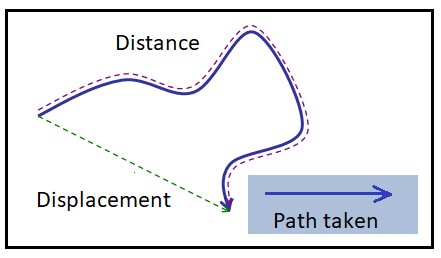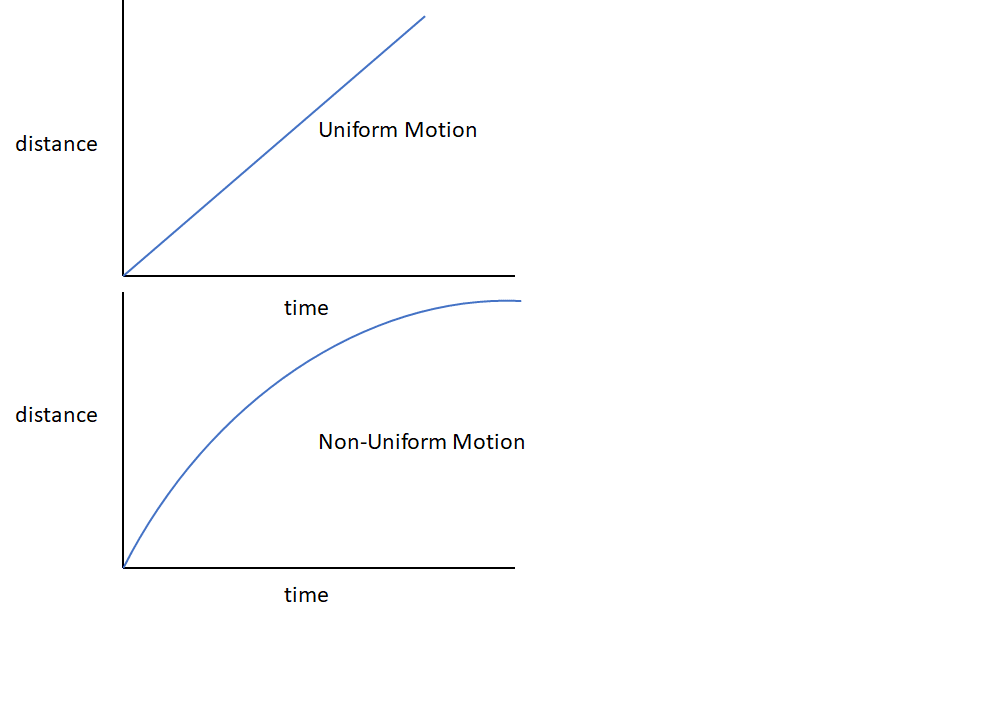Forces and Motion
Grade 8 Science Worksheets
Introduction to Motion
What if someone said that even if you are sitting completely still, you are in constant motion? Everything in the universe is in motion. The earth rotates around its axis and revolves around the sun, moving you constantly along with it. The proof of your movement is in reference to the sun or the moon or some other heavenly objects.
Imagine that you are in a moving train. When a person on the platform observes you, he sees you in motion. However, if you observe the person sitting next to you in the same train, he appears perfectly still with respect to you. Motion is determined by the difference between the positions of two objects or observers.
If you are in a moving car and there’s another car alongside, moving slightly faster than yours, you see a very small difference in motion with respect to your car or your position. Yet, both cars would appear as moving very fast to a stationary observer.
Every motion is in relation to some other place or object in the universe – it is with respect to a frame of reference. Every motion is an apparent motion with respect to that frame of reference.
Schedule a Free session to clear worksheet doubts
No credit card required, no obligation to purchase.
Just schedule a FREE Sessions to meet a tutor and get help on any topic you want!
What is Force?
An object at rest can only be put into motion by a cause. When you push a stationary cart, it starts to move. This cause, which changes the motion of an object, is Force. Force can cause an object to move, it can also cause an object to change direction, and it can cause an object to slow down and stop. When you hit a ball coming towards you, with a bat, you are applying force to change the direction of that ball. When you roll a ball on a rough carpet, it eventually slows down because the friction (a kind of force) between the carpet and the ball slows the ball down.
Measuring Motion – Speed
Motion is determined in relation to time and distance, and is referred to as Speed. Speed determines how far an object has moved in a period of time. It is the Rate of Motion. A car that has moved 60 kilometers in an hour determines its speed. However, as the car would have moved at different speeds over the hour, starting from a position of rest (zero speed) and increasing its speed gradually so as to cover 60 kilometers in one hour, it is often referred to as Average Speed. It is a distance per time ratio.
Average Speed =Distance/Time
Velocity
The calculation of speed is not bothered with direction of motion. If we speak of the motion of an object that is moving due south at 60 kilometers per hour, we are referring to the Velocity of the object. It has a magnitude (its speed) as well as a direction (south). Velocity refers to the displacement of a body rather than the distance traveled. It is a displacement per time ratio in a particular direction.


Uniform and Non-Uniform Motion
When both the speed and direction of a moving object are constant, the motion of the object is said to be Uniform – it covers equal distance in equal intervals of time. A car that covers 30 meters in every second is said to have a uniform speed of 30 meters per second. An object that covers unequal distances in equal intervals of time is said to have Non-uniform motion. A horse that runs a race at different speeds at different points of time would be a good example.
Learn more about Forces and Motion and other important topics with 8th Grade Science Tutoring at eTutorWorld. Our expert science tutors break down the topics through interactive one-to-one sessions. We also offer the advantage of customized lesson plans, flexible schedules and convenience of learning from home.
eTutorWorld Understands Math Tutoring | Online Math Worksheets are Important Tools
Understanding graphs, charts, and opinion polls in a newspaper, for calculating house and car payments, and for choosing a long-distance telephone service are impossible without strong math skills …and the only way to develop strong math skills is by constant practice.
‘Practice makes a man perfect’ holds true for no other field better than for math. A middle or high school student must set aside a minimum of an hour for math every day. Other than textbooks, worksheets help you revise and understand concepts better.
Our expert tutors prepare online maths worksheets that are age and grade-appropriate. Grade-wise math worksheets for Elementary Math, Arithmetic, Pre-Algebra, Algebra, Geometry, Trigonometry, Statistics, Pre-Calculus and Calculus can be solved to improve math skills, to get ahead or to even catch up.
You may download these FREE online math worksheets in the PDF format, and then print and email us their solutions for a free evaluation and analysis by eTutorworld’smath expert tutors.
You may solve these worksheets by yourself or with your peers while studying together.
The Answer Key at the end of each worksheet allows for a self-evaluation.
Personalized Online Tutoring
eTutorWorld offers affordable one-on-one live tutoring over the web for Grades K-12, Test Prep help for Standardized tests like SCAT, CogAT, MAP, SSAT, SAT, ACT, ISEE and AP. You may schedule online tutoring lessons at your personal scheduled times, all with a Money-Back Guarantee. The first one-on-one online tutoring lesson is always FREE, no purchase obligation, no credit card required.
For answers/solutions to any question or to learn concepts, take a FREE CLASS.
No credit card required, no obligation to purchase.
Just book a free class to meet a tutor and get help on any topic you want!
Acceleration
If the velocity of an object changes (increases) from one time period to another, the object is said to have accelerated – here Acceleration has occurred. Similarly, if the velocity has decreased from one time period to another, a Deceleration (or negative acceleration) is said to have occurred. A car which moves at 10 miles per hour for the first minute, then at 20 miles per hour for the second minute and finally at 30 miles per hour for the third minute, would have a Uniform Acceleration of “10 miles per hour per minute”. If the car slowed down at the same rate it would be a Uniform Deceleration. If the rates of acceleration or deceleration vary from one time period to another, then it is said to have Variable Acceleration or Variable Deceleration.
The formula to calculate acceleration is as follows –
Acceleration= | Final velocity – Starting velocity Elapsed Time |
For example, if a car accelerates from 0 miles per hour to 60 miles per hour in 30 seconds then the acceleration of the car would be –

Check Point
1) Use the formula for average speed to fill the missing values in the table:
| Average Speed | Distance | Time |
1a | ? | 30 meters | 30 seconds |
1b | 10 miles per hour | 20 miles | ? |
1c | 3 kilometers per minute | ? | 20 minutes |
2) What is the average speed of a car that has traveled across 4 distances as below?
Average Speed | Distance | Time |
Segment 1 Segment 2 Segment 3 Segment 4 | 30 miles 40 miles 25 miles 45 miles | 1 hour 1 hour 1.5 hours 1.5 hours |
3) Calculate the acceleration of a train which accelerates from 60 kilometers per hour to 120 kilometers per hour in 20 minutes.
Answer Key
1a) Average speed is 1 meter per second
1b) Time taken is 2 hours
1c) Distance traveled is 60 kilometers
- The average speed is 28 miles per hour
- The acceleration is 3 kilometers per hour per minute
Schedule a Free session to clear worksheet doubts
No credit card required, no obligation to purchase.
Just schedule a FREE Sessions to meet a tutor and get help on any topic you want!
Pricing for Online Tutoring
8th Grade Free Worksheets
- The Universe
- Heredity
- Evolutionary Theory
- Structure of the atom
- Ethical Practices
- Unveiling the mystery behind the physical universe
- Components of the universe
- Celestial phenomena
- The tilt of Earth’s axis
- The causes of high and low tides
- Earth Systems
- Rocks and Fossils
- Weather and Climate
- Basics of chemical reactions
- Types of Chemical reactions – Endothermic, exothermic, oxidation, reduction reactions
- Catalysts and enzymes
- Compounds and mixtures
- Acids, Bases and pH Indicators
IN THE NEWS

Our mission is to provide high quality online tutoring services, using state of the art Internet technology, to school students worldwide.
Online test prep and practice
SCAT
SSAT
ISEE
PSAT
SAT
ACT
AP Exam
Science Tutoring
Physics Tutoring
Chemistry Tutoring
Biology Tutoring
Math Tutoring
Pre-Algebra Tutoring
Algebra Tutoring
Pre Calculus Tutoring
Calculus Tutoring
Geometry Tutoring
Trigonometry Tutoring
Statistics Tutoring
Quick links
Free Worksheets
Fact sheet
Sales Partner Opportunities
Parents
Passive Fundraising
Virtual Fundraising
Our Expert Tutors
Safe and Secure Tutoring
Interactive Online Tutoring
After School Tutoring
Elementary School Tutoring
Middle School Tutoring
High School Tutoring
Home Work Help
Math Tutors New York City
Press
©2022 eTutorWorld Terms of use Privacy Policy Site by Little Red Bird
©2022 eTutorWorld
Terms of use
Privacy Policy
Site by Little Red Bird






